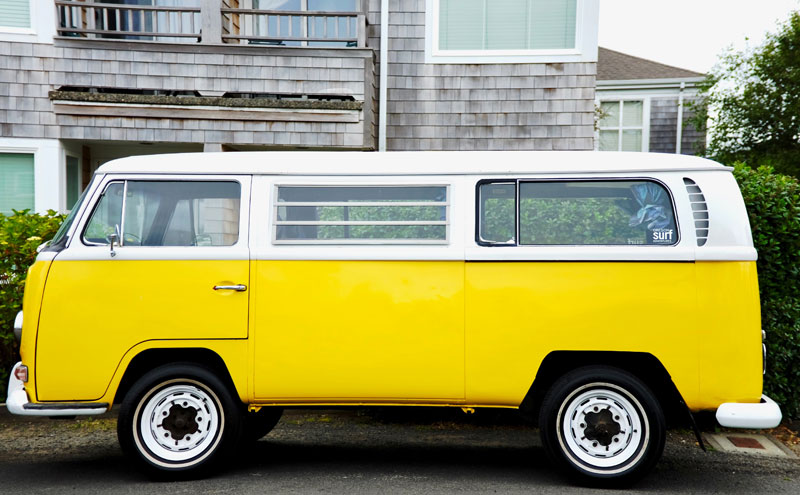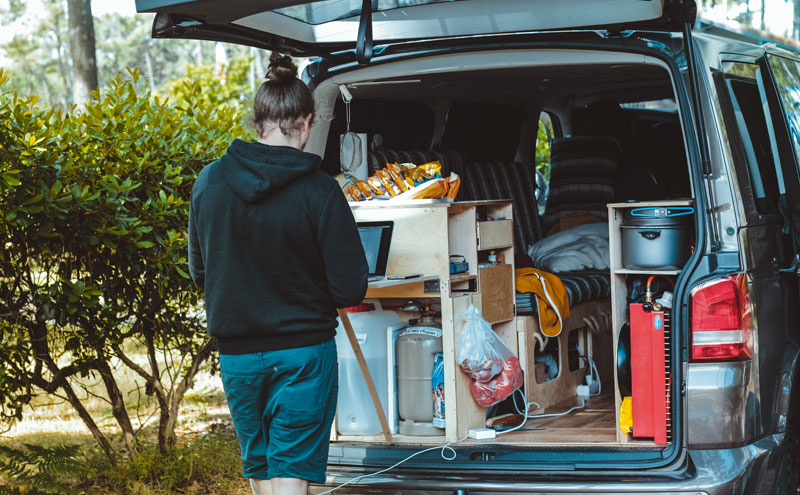Most people spend on average $1,000 to $2,000 per month on gas, food, and other living expenses for their total van life cost.
Yet, this number does vary from person to person based on monthly budget and travel plans. We have a way to calculate an average for yourself based on your lifestyle, along with some other factors that contribute to your cost.
We'll be giving a breakdown with 7 actionable steps to escape the 9 to 5 and enjoy the freedom and outdoor adventures of van life. In addition, there will be examples of other van lifers and how they manage their finances on the road.
Step 1 - Choosing your van ($0 to $30,000)
The first step, and largest upfront cost is going to be which van you decide to go with. There's actually a full guide on what type of vehicle you should buy.
Some people may already own a van that they can live in. Without much conversion, it can be done and you can live the lifestyle quite fine.
Other people spend upwards of $30,000 on custom decked out vans. Despite what you may see on Instagram or YouTube, not everyone lives like this.
Should you get an old or new vehicle for van life?

It may be worth it to get a new van with a monthly payment if you can afford it. You have to consider that with an old van, it may tend to break down in random places. Sure you get that classic charm with an old van, yet it could have more problems.
This will cost you additional time, money, and headaches. Sometimes this could even be thousands (for transmission or emission related work). Can you put a price tag on piece of mind?
Step 2 - Sell your stuff (+$$$ Make money)
A great way to lower your costs and make a little money while doing it is to sell anything you don't need. By choosing to live in a small space, well you don't have much extra room. These are some great sites and apps to get rid of your stuff:
- eBay
- Craigslist
- Let go
- Offer up

Living on the road and the van life also means you're taking a dive into minimalism. For some you may even decide to sell your house to lower your additional expenses quite a bit. Of course you would be sacrificing that "home base".
In contrast, you could also opt for a storage unit to keep any other things you can't fit in your van. (Or you could even ask your parents to store it, if they love you enough).
Step 3 - Phone, WiFi & Internet ($35 to $120 per month)
Of course staying connected is absolutely essential for many living a nomadic or "on the road" lifestyle. It can be useful for:
- Entertainment
- Staying in touch with friends and family
- Planning travels ahead of time
- Working remotely online
The following YouTube video explains the different options of ways to get connected to the internet while on the road:
In addition to this video, the creators also have a website called RV Mobile Internet for more help with this subject matter.
Step 4 - Food, Water, and Electric ($150 to $300 per month)
These three are the essentials necessary for sustaining life inside a van. Without it, well you can kiss your life goodbye.
Food: This will vary a decent bit from person to person. Based on certain dietary restrictions or gender, height and weight, it may be more or less. This will be the bulk of your cost in this area.
In addition to food, many also go out to eat or grab coffee at local shops. This can increase your cost of living, yet it also gives a co-working space to get stuff done.

Water: One aspect some may wonder is where to find water for a campervan water tank. Many times you can actually get water for free when you get crafty. Otherwise you can purchase water jugs from the grocery store. For showering many people also go for a gym membership as a low cost option.
Electric: Many people opt for solar energy in order to stay fully sustainable on the road. This also allows you to live off grid if you want to travel in some more remote areas. Not to mention, the sun's energy is free after solar panel installation.
Step 5 - Rent & Insurance ($0 to $300 per month)
Ha, kidding with the rent aspect. That's the whole benefit of van life! No more rent payments! However, you may want to stay in campgrounds or state parks at times. This will be an extra cost to factor in.
Some may include campgrounds as a travel expense, that's up for you to decide. A simple way to avoid any costs and camp for free is to boondock. This means staying in parking lots or anywhere else safe to stay overnight. Dry camping or boondocking allows you to stay low key and off grid.

There are also a few other expenses like insurance that you'll want to keep paying for any emergencies that may occur. This can range from personal health insurance to car insurance for your van.
Step 6 - Plan your travels (cost of gas/parks)
The most controllable element of your outgoing expenses other than food will be your travels. Now, the whole benefit of your choice for van life is the travel. Yet, if you cannot afford to go cross-country this month, save your money instead. You can stay low key and live without many costs.
Pro tip: Get a national park pass from the National Park Service. This grants you free entry to all national parks for your adventure travels.

Step 7 - Always be prepared/additional gear (ranges)
In addition to any insurance costs for emergencies you may also need gear. This could be included in the initial cost of your van, or on a per month basis for cooking supplies and such. This ranges depending on where you plan to travel to and what you may need for certain weather conditions.
Lifestyle Cost Ranges for Van Life
After calculating a range for each different piece of your total cost of living, there are also some options. Some people want to keep their van life cost very low, while others want to travel and see the country. Below are some ideas of cost brackets and different lifestyle options. This van life documentary also goes over a lot of different lifestyle options for those living on the road.
Option #1 - Stationary Van Life (Cost: $200-500 per month)
This option is for people who want to live minimal, and work their job without moving much. You can achieve the "van life" and have a more simple lifestyle for quite cheap per month. In this option you won't be traveling much at all, rather staying in one place and treating your van as a stationary home. You can keep your costs very low with this bare minimum option.
PROS
CONS
Option #2 - Average Van Life (Cost: $1,200 per month)
Most people looking to get into van life will fall into this category. You work remotely online, and travel around to different adventure locations. This gives you a gas budget for driving around and for going out to eat occasionally. Most meals will be cooked inside your van. You'll have budget for a solid insurance plan in case anything goes wrong with your health or vehicle.
PROS
CONS
Option #3 - Boujee Van Life (Cost: $2,000+ per month)
If you're looking at the Instagram #vanlife, then this is where you'll find that. This option is for those who want to go long distances in their van, and go out to eat or for coffee on a regular basis. You can catch those wicked views, and live the full lifestyle.
Many even stay inside campgrounds or state parks for periods of time. You work remotely to bring in an income and with extra money to set aside for savings. You'll have insurance for health, life, and your vehicle. Many in this category also tend to have a gym membership or other additional expenses.
PROS
CONS
Example Van Lifers
On top of the steps for figuring out your cost for van life, I also put together a comprehensive list of some fellow van lifers. This will give you an idea of the total cost for other people and what they've created. This includes their van cost, and the cost of van life per month. The costs also vary based on if you live alone, or with your significant other as a couple.
#1 - Where's Your Neighborhood (Monthly Cost: $1,300)
This video goes over how much it costs to live in a van and travel the country. The first month cost him more than average due to additional gas costs and travel. Otherwise he would be on the more minimal side with $600 for his second month of van life. The expenses breakdown:
- Gas: $660 (drove cross-country, higher cost than normal)
- Groceries: $450
- Car payment: $300 (not in final total)
- Miscellaneous: $145
- Car insurance: $100
- Phone: $100
- Eating out: $60
- Unlimited hot spot: $33
- Coffee: $30
TOTAL: $1,345 per month
#2 - Alexander Travelbum (Monthly Cost: $1,200)
Alexander Travelbum and his partner travelbuni went far south for this month and fit into the average van life cost. They also mention how they spent more on groceries for the month than normal, and will budget better. The expenses breakdown:
- Groceries: $560
- Gas: $320
- Car insurance: $109
- Eating out: $60
- Warmth/hotel: $55
- Souvenirs: $38
- Vehicle maintenance: $32
- Coffee: $30
- Gym membership: $20
- Toiletries: $10
- Firewood: $10
- Park fees: $10
- Movies: $8
- National parks pass: $7
- Parking: $5
TOTAL: $1,274 per month
#3 - The Matneys (Monthly Cost: $2,000+)
The Matneys work remotely and spend a bit more when it comes to their lifestyle. This gives an excellent breakdown of each expense they have to live on the road. Their expenses breakdown:
- Eating out: $350
- Groceries: $350
- Coffee: $300
- Gas: $300
- Health insurance: $249
- Investments: $200
- Car insurance: $184
- Internet & phone: $120
- Life insurance: $50
- Gym membership: $40
- Spotify: $15
TOTAL: $2,158 per month
To Conclude
This is a huge life decision to get into, and not something to take lightly without doing plenty of research. I would love to get into van life myself in the future and have been researching this quite a bit. Each of the van life costs and options in this post are estimates and not exact representations.
For me it seems like the best option is to keep a home as a base camp. Then, to travel in the van for a couple weeks at a time.
Ultimately, what choice you make depends on a per person basis. Consider your per month income and overall finances. There's definitely some places where you can cut down expenses that you don't need.
It may not be perfect, but if you make that leap you'll be one step closer to traveling on your adventures!

